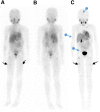Norepinephrine Transporter as a Target for Imaging and Therapy
- PMID: 28864611
- PMCID: PMC5577620
- DOI: 10.2967/jnumed.116.186833
Norepinephrine Transporter as a Target for Imaging and Therapy
Abstract
The norepinephrine transporter (NET) is essential for norepinephrine uptake at the synaptic terminals and adrenal chromaffin cells. In neuroendocrine tumors, NET can be targeted for imaging as well as therapy. One of the most widely used theranostic agents targeting NET is metaiodobenzylguanidine (MIBG), a guanethidine analog of norepinephrine. 123I/131I-MIBG theranostics have been applied in the clinical evaluation and management of neuroendocrine tumors, especially in neuroblastoma, paraganglioma, and pheochromocytoma. 123I-MIBG imaging is a mainstay in the evaluation of neuroblastoma, and 131I-MIBG has been used for the treatment of relapsed high-risk neuroblastoma for several years, however, the outcome remains suboptimal. 131I-MIBG has essentially been only palliative in paraganglioma/pheochromocytoma patients. Various techniques of improving therapeutic outcomes, such as dosimetric estimations, high-dose therapies, multiple fractionated administration and combination therapy with radiation sensitizers, chemotherapy, and other radionuclide therapies, are being evaluated. PET tracers targeting NET appear promising and may be more convenient options for the imaging and assessment after treatment. Here, we present an overview of NET as a target for theranostics; review its current role in some neuroendocrine tumors, such as neuroblastoma, paraganglioma/pheochromocytoma, and carcinoids; and discuss approaches to improving targeting and theranostic outcomes.
Keywords: 18F-MFBG; MIBG; neuroblastoma; neuroendocrine; norepinephrine transporter.
© 2017 by the Society of Nuclear Medicine and Molecular Imaging.
Figures




References
-
- Stöber G, Nöthen MM, Pörzgen P, et al. Systematic search for variation in the human norepinephrine transporter gene: identification of five naturally occurring missense mutations and study of association with major psychiatric disorders. Am J Med Genet. 1996;67:523–532. - PubMed
-
- Mandela P, Ordway GA. The norepinephrine transporter and its regulation. J Neurochem. 2006;97:310–333. - PubMed
-
- Höpfner M, Sutter AP, Beck NI, et al. Meta-iodobenzylguanidine induces growth inhibition and apoptosis of neuroendocrine gastrointestinal tumor cells. Int J Cancer. 2002;101:210–216. - PubMed
-
- Wieland DM, Swanson DP, Brown LE, Beierwaltes WH. Imaging the adrenal-medulla with an I-131-labeled antiadrenergic agent. J Nucl Med. 1979;20:155–158. - PubMed
-
- Lashford LS, Hancock JP, Kemshead JT. Meta-iodobenzylguanidine (mIBG) uptake and storage in the human neuroblastoma cell line SK-N-BE(2C). Int J Cancer. 1991;47:105–109. - PubMed
Publication types
MeSH terms
Substances
Grants and funding
LinkOut - more resources
Full Text Sources
Other Literature Sources
Medical
